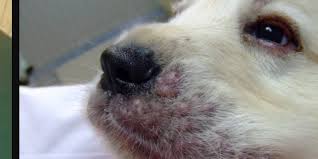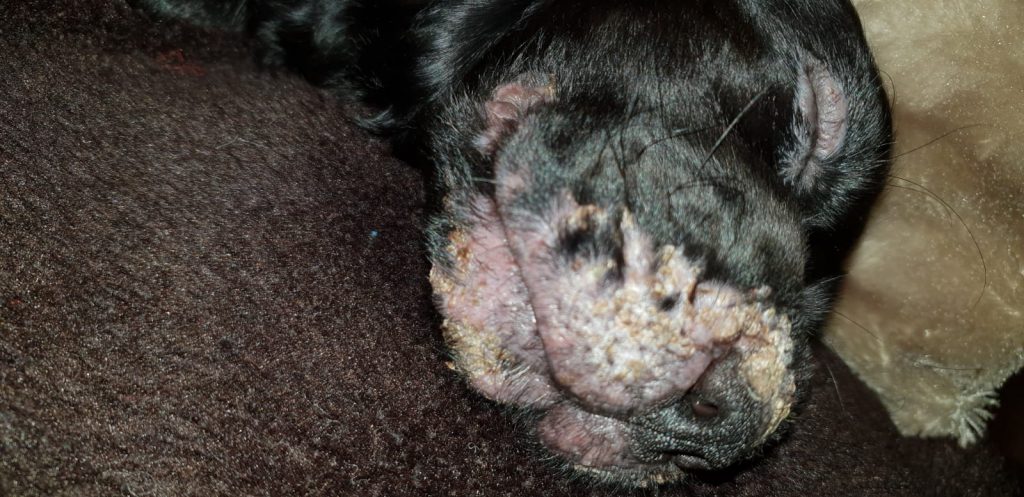Juvenile cellulitis, also known as puppy strangles, is a rare skin condition that is typically found in puppies. It is also known as lymphadenitis, sterile granulomatous dermatitis, and juvenile cellulitis. Puppy strangles is a rare skin condition that typically affects puppies between the ages of one and six months. Rarely, it can develop in dogs that are young adults and younger than four years old. We’ll talk about puppy strangles in this article, including the causes, symptoms, and available treatments.
What Is Puppy Strangles (Juvenile Cellulitis)?
A rare skin condition that affects puppies is called puppy strangles, also referred to as juvenile cellulitis. Puppy strangles are thought to be caused by immune system dysregulation, although the exact cause is unknown.
Puppy strangles cause lymph node enlargement, pustular dermatitis, and facial swelling (edema). It is impossible for humans or other dogs to contract puppy strangles. Juvenile cellulitis can affect puppies as young as 3 weeks old and as old as 4 months, though the age at which it first manifests in a puppy varies.
Symptoms Of Puppy Strangles In Dogs
Sudden and severe swelling of the puppy’s face is one of the first indications of puppy strangles. Other symptoms may appear after this swelling.
They may experience swelling, redness, and irritation of their lips, ear flaps, or eyelids. On the puppy’s skin, bumps or pimples may also appear that are raised or filled with pus.
Over time, the bumps and pimples swell, burst, and crust over, which can leave the injured area severely scarred. Puppy strangles should be treated right away to prevent the swelling and bumps from spreading to other areas of the dog’s body.
Dogs may also develop jaw swelling. They develop tender, swollen lymph nodes on either side of their necks when they have puppy strangles. The lymph nodes could eventually burst and then drain, leaving your dog’s skin covered in oozing trails.
You’ll see that puppies who have puppy strangles frequently display other symptoms that something is wrong. They might have:
- Low energy levels
- Difficulty eating or appetite loss
- Fever
- Joint pain
- Depression
- Hair loss
Puppies who exhibit puppy strangle symptoms need to receive immediate medical attention from a veterinarian. Do not try to pop or squeeze the bumps or pimples. Your dog might get hurt, and it might scar permanently.
Causes Of Puppy Strangles In Dogs
Puppy strangles are unknown in their exact cause, but because they most frequently affect young dogs whose immune systems are still developing, experts believe that an inappropriate immune response is to blame. Additionally, it frequently reacts to steroids taken in high doses because they suppress the immune system.
Given that some breeds are more susceptible to developing it, such as Golden Retrievers, Gordon Setters, and Dachshunds, there may also be a hereditary component.
Diagnosing Puppy Strangles
The veterinarian will first perform a number of tests to rule out other, more prevalent skin conditions such as ringworm or mange (a skin condition brought on by mites). Some tests may include:

- Bloodwork, such as a complete blood count: Anemia (low red blood cell count) and an elevated white blood cell count are frequent symptoms of strangles in dogs.
- Cytology of the skin lesions: The oozing lesions are covered with a glass slide, which is then examined under a microscope (or sent to a lab for analysis). The sample is used to identify any secondary bacterial infections that the dog may have acquired as a result of its strangles.
- Skin scrapings and hair pluck testing: These tests can aid in eliminating other potential causes of skin lesions, such as ringworm, mange, and fungus.
- Bacterial or fungal cultures: To rule out infection, these tests might be suggested.
- Skin biopsy: Since it looks for specific skin changes associated with puppy strangles, like granulomas and pyogranulomas, it can provide a conclusive diagnosis. However, given how aggressive the test is, it is frequently unnecessary for the diagnosis and treatment of the condition.
The veterinarian may also take tissue samples from the dog to test for any additional infections that the dog may be suffering from. Additionally, the puppy’s neck may be checked for swollen lymph nodes, which are frequently an indication of puppy strangles.
Treatment For Puppy Strangles
The treatment aims to halt the auto-immune reaction that causes the puppy to strangle because the condition is thought to be an immune-system-affecting disease.
High doses of oral corticosteroids (like prednisone) are typically used as a treatment to suppress the immune system.
The medication is administered over a period of weeks while the dog is observed and under professional care, beginning with a high dosage and reducing it over time. After receiving treatment for a few days, the puppy will typically react favorably and start to heal.
Puppy ointment may help to relieve the skin’s irritation and pain. The veterinarian might also advise antibiotics if a secondary bacterial infection is discovered. This can lessen some skin inflammation in the puppy and speed up the healing process. Only very rarely might chemotherapy be necessary.
Puppy strangles typically do not recur, but scarring sometimes does.
Recovery And Management Of Puppy Strangles In Dogs
Puppies with puppy strangle typically begin to improve within a few days of beginning treatment, but it could take up to 10 to 14 days for the condition to completely clear up. Keep in mind that some skin scars or hair loss may be permanent. Avoid popping any pustules as doing so can hurt your dog and make it easier for a bacterial infection to develop.
Currently, there is no known way to prevent puppy strangles, but once it has been treated, it typically does not recur.
Cost Of Puppy Strangles In Dogs
The puppy may not survive if left untreated for an extended period of time. Prednisone ($40 for 100ct.) is one of the medications your veterinarian may choose and is commonly used to treat inflammatory diseases.
Prednisone is frequently combined with an antibiotic (such as Cephalexin, Cefadroxil, or Amoxicillin Clavulanate). Cephalexin 500 mg, costing $30 for 100ct.) is used to treat infections that are caused by bacteria. Prednisone and cephalexin generally have a combined price of about $70. Cefadroxil ($30 for 50 milliliters). or $60 for 100ml.) is usually in liquid form and is also an antibiotic that is used to treat bacterial infections.
Prednisone and cefadroxil typically cost between $70 and $100. Lastly, 500mg of amoxicillin-clavulanate ($20 per 100ct.) is an antibiotic also used to treat bacterial infections. Amoxicillin clavulanate and prednisone typically cost around $60 when purchased together.
The best chance for a positive outcome for your puppy is when prednisone is combined with an antibiotic.
How Can Puppy Strangles Be Avoided?
Currently, there is no known way to stop this condition. It is always advised to purchase a puppy from a reputable breeder or humane society when looking for one, though.
If your puppy displays symptoms, your veterinarian can advise you on the most effective course of treatment and assist you in determining whether your dog has an underlying immune system disorder.
FAQs
Can Puppy Strangulation Be Treated?
In general, the answer is yes, and it is extremely uncommon to see a puppy relapse after healing from puppy strangles. The likelihood of a complete recovery is very good.
How Are Puppy Strangles Contracted In Dogs?
It is impossible for humans or other dogs to contract puppy strangles. Although the exact cause of juvenile cellulitis in puppies is unknown, a compromised immune system is thought to be the cause.





